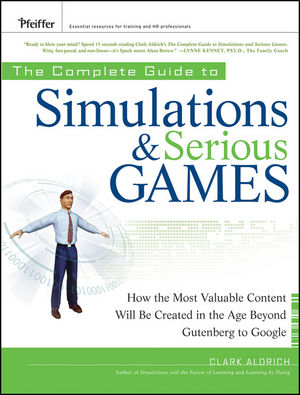The Complete Guide to Simulations and Serious Games: How the Most Valuable Content Will be Created in the Age Beyond Gutenberg to GoogleISBN: 978-0-470-46273-7
Hardcover
576 pages
October 2009, Pfeiffer
 This title is out-of-print and not currently available for purchase from this site.
|
Preface: The Elements of Interactivity.
Introduction: Capturing the Wisdom That Has Fallen through the Cracks of Gutenberg and Google.
The Most Important Skills.
The Campfire and the Veld.
How to Use This Book.
The Babel Problem—“Serious Games” or “Educational Simulations”.
A New Science.
PART ONE Genres: Savior or Saboteur for Literacy 2.0?
1 Sims—The New Media of “Learning to Do” Not Just “Learning to Know”.
2 Immersive Learning Simulation: Because You Can’t Learn to Ride a Bicycle from a Book.
3 Computer Games.
4 Traditional Education.
PART TWO Simulation Elements—Actions and Results: Framing The Missing Essence Of Research And Analysis.
5 Basic Actions.
6 Middle Skills—Design Patterns for More Complicated Actions.
7 Desired Results.
PART THREE Simulation Elements of Systems: Connecting Actions and Results.
8 Maps: The Context for Life.
Systems That Act as Triggers.
9 Units: How CEOs, Presidents, and Hostile Aliens View Life on Earth.
10 Artificial Intelligence Player-Agent: More Patient Than Real People.
11 State-Based Systems and Models: A Shortcut to Simulations.
12 Pure Mathematical System: The Real Stuff.
13 Work Process.
14 Big Skills: The Most Important Twenty-First-Century Skills.
PART FOUR Building Interactive Environments.
15 Linear Content.
16 Game Elements: A Spoonful of Sugar If You Can Avoid Hypoglycemic Shock.
17 Pedagogical Elements: Learn Faster and Better.
18 Tasks and Levels.
19 Display.
20 Community.
21 Basic Inputs.
PART FIVE Formal Learning Program.
22 Learning Goals.
23 Program Goals.
24 Target Audiences and Corresponding Learning and Program Goals.
Target Audience
25 When to Use Sims—Meeting Both Learning and Program Goals.
26 Educational Simulation Creation and Milestones Part 1: An Overview of Key Steps.
27 Educational Simulation Creation and Milestones Part 2: Calibrating Skill Cones and Designing the Different Layers of Feedback.
28 The Necessary Student Experience of Frustration and Resolution.
29 Evaluation Strategies and the Analysis of Learning.
30 Conclusion: Banishing Today’s Classrooms, Curricula, Term Papers, Training Programs, Business Plans, and Linear Analysis to the Intellectual Slums and Backwaters to Which They So Richly Belong.
Appendix: Simulation Case Studies: Do Sims Work Better Than Traditional Instruction?
About the Author.
Index.



